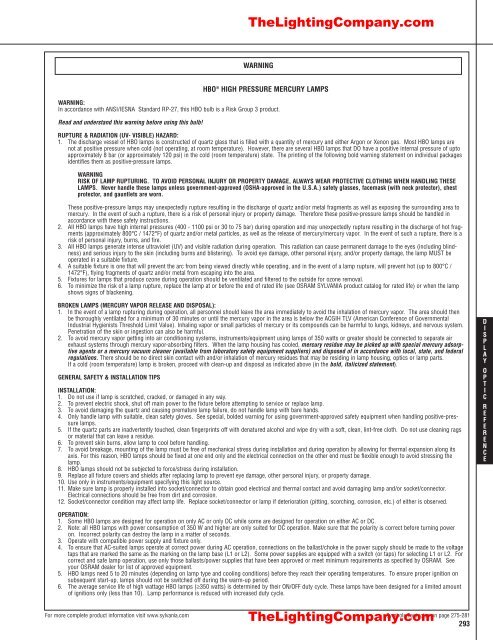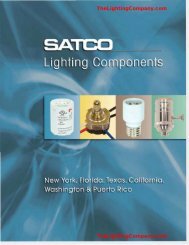Lamp and Ballast Catalog - The Lighting Company
Lamp and Ballast Catalog - The Lighting Company
Lamp and Ballast Catalog - The Lighting Company
- No tags were found...
Create successful ePaper yourself
Turn your PDF publications into a flip-book with our unique Google optimized e-Paper software.
<strong>The</strong><strong>Lighting</strong><strong>Company</strong>.com<br />
WARNING<br />
HBO ® HIGH PRESSURE MERCURY LAMPS<br />
WARNING:<br />
In accordance with ANSI/IESNA St<strong>and</strong>ard RP-27, this HBO bulb is a Risk Group 3 product.<br />
Read <strong>and</strong> underst<strong>and</strong> this warning before using this bulb!<br />
RUPTURE & RADIATION (UV- VISIBLE) HAZARD:<br />
1. <strong>The</strong> discharge vessel of HBO lamps is constructed of quartz glass that is filled with a quantity of mercury <strong>and</strong> either Argon or Xenon gas. Most HBO lamps are<br />
not at positive pressure when cold (not operating, at room temperature). However, there are several HBO lamps that DO have a positive internal pressure of upto<br />
approximately 8 bar (or approximately 120 psi) in the cold (room temperature) state. <strong>The</strong> printing of the following bold warning statement on individual packages<br />
identifies them as positive-pressure lamps.<br />
WARNING<br />
RISK OF LAMP RUPTURING. TO AVOID PERSONAL INJURY OR PROPERTY DAMAGE, ALWAYS WEAR PROTECTIVE CLOTHING WHEN HANDLING THESE<br />
LAMPS. Never h<strong>and</strong>le these lamps unless government-approved (OSHA-approved in the U.S.A.) safety glasses, facemask (with neck protector), chest<br />
protector, <strong>and</strong> gauntlets are worn.<br />
<strong>The</strong>se positive-pressure lamps may unexpectedly rupture resulting in the discharge of quartz <strong>and</strong>/or metal fragments as well as exposing the surrounding area to<br />
mercury. In the event of such a rupture, there is a risk of personal injury or property damage. <strong>The</strong>refore these positive-pressure lamps should be h<strong>and</strong>led in<br />
accordance with these safety instructions.<br />
2. All HBO lamps have high internal pressures (400 - 1100 psi or 30 to 75 bar) during operation <strong>and</strong> may unexpectedly rupture resulting in the discharge of hot fragments<br />
(approximately 800°C / 1472°F) of quartz <strong>and</strong>/or metal particles, as well as the release of mercury/mercury vapor. In the event of such a rupture, there is a<br />
risk of personal injury, burns, <strong>and</strong> fire.<br />
3. All HBO lamps generate intense ultraviolet (UV) <strong>and</strong> visible radiation during operation. This radiation can cause permanent damage to the eyes (including blindness)<br />
<strong>and</strong> serious injury to the skin (including burns <strong>and</strong> blistering). To avoid eye damage, other personal injury, <strong>and</strong>/or property damage, the lamp MUST be<br />
operated in a suitable fixture.<br />
4. A suitable fixture is one that will prevent the arc from being viewed directly while operating, <strong>and</strong> in the event of a lamp rupture, will prevent hot (up to 800°C /<br />
1472°F), flying fragments of quartz <strong>and</strong>/or metal from escaping into the area.<br />
5. Fixtures for lamps that produce ozone during operation should be ventilated <strong>and</strong> filtered to the outside for ozone removal.<br />
6. To minimize the risk of a lamp rupture, replace the lamp at or before the end of rated life (see OSRAM SYLVANIA product catalog for rated life) or when the lamp<br />
shows signs of blackening.<br />
BROKEN LAMPS (MERCURY VAPOR RELEASE AND DISPOSAL):<br />
1. In the event of a lamp rupturing during operation, all personnel should leave the area immediately to avoid the inhalation of mercury vapor. <strong>The</strong> area should then<br />
be thoroughly ventilated for a minimum of 30 minutes or until the mercury vapor in the area is below the ACGIH TLV (American Conference of Governmental<br />
Industrial Hygienists Threshold Limit Value). Inhaling vapor or small particles of mercury or its compounds can be harmful to lungs, kidneys, <strong>and</strong> nervous system.<br />
Penetration of the skin or ingestion can also be harmful.<br />
2. To avoid mercury vapor getting into air conditioning systems, instruments/equipment using lamps of 350 watts or greater should be connected to separate air<br />
exhaust systems through mercury vapor-absorbing filters. When the lamp housing has cooled, mercury residue may be picked up with special mercury adsorptive<br />
agents or a mercury vacuum cleaner (available from laboratory safety equipment suppliers) <strong>and</strong> disposed of in accordance with local, state, <strong>and</strong> federal<br />
regulations. <strong>The</strong>re should be no direct skin contact with <strong>and</strong>/or inhalation of mercury residues that may be residing in lamp housing, optics or lamp parts.<br />
If a cold (room temperature) lamp is broken, proceed with clean-up <strong>and</strong> disposal as indicated above (in the bold, italicized statement).<br />
D<br />
ISPLAY<br />
O<br />
PTIC<br />
R<br />
EFERENCE<br />
GENERAL SAFETY & INSTALLATION TIPS<br />
INSTALLATION:<br />
1. Do not use if lamp is scratched, cracked, or damaged in any way.<br />
2. To prevent electric shock, shut off main power to the fixture before attempting to service or replace lamp.<br />
3. To avoid damaging the quartz <strong>and</strong> causing premature lamp failure, do not h<strong>and</strong>le lamp with bare h<strong>and</strong>s.<br />
4. Only h<strong>and</strong>le lamp with suitable, clean safety gloves. See special, bolded warning for using government-approved safety equipment when h<strong>and</strong>ling positive-pressure<br />
lamps.<br />
5. If the quartz parts are inadvertently touched, clean fingerprints off with denatured alcohol <strong>and</strong> wipe dry with a soft, clean, lint-free cloth. Do not use cleaning rags<br />
or material that can leave a residue.<br />
6. To prevent skin burns, allow lamp to cool before h<strong>and</strong>ling.<br />
7. To avoid breakage, mounting of the lamp must be free of mechanical stress during installation <strong>and</strong> during operation by allowing for thermal expansion along its<br />
axis. For this reason, HBO lamps should be fixed at one end only <strong>and</strong> the electrical connection on the other end must be flexible enough to avoid stressing the<br />
lamp.<br />
8. HBO lamps should not be subjected to force/stress during installation.<br />
9. Replace all fixture covers <strong>and</strong> shields after replacing lamp to prevent eye damage, other personal injury, or property damage.<br />
10. Use only in instruments/equipment specifying this light source.<br />
11. Make sure lamp is properly installed into socket/connector to obtain good electrical <strong>and</strong> thermal contact <strong>and</strong> avoid damaging lamp <strong>and</strong>/or socket/connector.<br />
Electrical connections should be free from dirt <strong>and</strong> corrosion.<br />
12. Socket/connector condition may affect lamp life. Replace socket/connector or lamp if deterioration (pitting, scorching, corrosion, etc.) of either is observed.<br />
OPERATION:<br />
1. Some HBO lamps are designed for operation on only AC or only DC while some are designed for operation on either AC or DC.<br />
2. Note: all HBO lamps with power consumption of 350 W <strong>and</strong> higher are only suited for DC operation. Make sure that the polarity is correct before turning power<br />
on. Incorrect polarity can destroy the lamp in a matter of seconds.<br />
3. Operate with compatible power supply <strong>and</strong> fixture only.<br />
4. To ensure that AC-suited lamps operate at correct power during AC operation, connections on the ballast/choke in the power supply should be made to the voltage<br />
taps that are marked the same as the marking on the lamp base (L1 or L2). Some power supplies are equipped with a switch (or taps) for selecting L1 or L2. For<br />
correct <strong>and</strong> safe lamp operation, use only those ballasts/power supplies that have been approved or meet minimum requirements as specified by OSRAM. See<br />
your OSRAM dealer for list of approved equipment.<br />
5. HBO lamps need 5 to 20 minutes (depending on lamp type <strong>and</strong> cooling conditions) before they reach their operating temperatures. To ensure proper ignition on<br />
subsequent start-up, lamps should not be switched off during the warm-up period.<br />
6. <strong>The</strong> average service life of high wattage HBO lamps (≥350 watts) is determined by their ON/OFF duty cycle. <strong>The</strong>se lamps have been designed for a limited amount<br />
of ignitions only (less than 10). <strong>Lamp</strong> performance is reduced with increased duty cycle.<br />
<strong>The</strong><strong>Lighting</strong><strong>Company</strong>.com<br />
For more complete product information visit www.sylvania.com Symbols/Footnotes on page 275-281<br />
293




